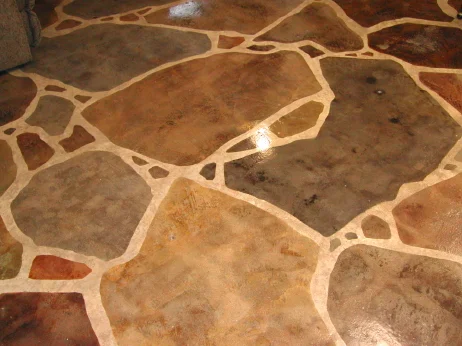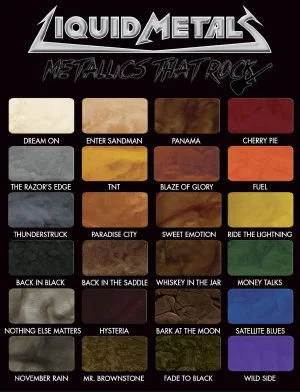CONCRETE Staining
This is a very realistic, faux-finish, interior "flagstone" floor, created by drawing a grout pattern, and individual rocks, on the concrete with soapstone, and then acid-staining the "rocks" one by one.
The main reason concrete floors are stained, in such numbers, by home and business owners, is that paint, even special concrete paint, does not adhere well to the cement on the surface of a concrete floor, or last very long. Concrete stain, under a durable, clear sealer, though, does adhere, and last, especially if the floor is cleaned and maintained regularly. Concrete stain is also chosen, instead of colored or metallic epoxy, for example, because the stain’s translucency helps make the concrete look stylish and expensive, like marble, granite, travertine, flagstone, and other forms of natural stone, instead of something flashy, or merely utilitarian and functional. Decorative concrete “scoring” (saw-cutting) is also often performed, when staining concrete floors, so as to create patterning effects that complement and enhance the "natural stone" appearance of acid stain. Here are some of the most popular stained concrete scoring patterns: Stained Concrete Scoring Patterns.
This church floor was acid-stained brown, to complement the wood pews, after removing lots of old carpet glue and paint spatter.
There is a great variety of concrete staining materials on the market. Acid stains, and the earth tone colors they offer, are the most popular, but for wider color range and variation, and greater control over detail, tints, concrete dyes, and acrylic concrete stains (water-based and solvent-based) are also used. For an illustration of basic acid stain colors, see these color charts: Brickform Blushtone; Brickform E-Stain; Artcrete Faux Brick; EZCHEM PermaPro; and CSI Chromastain . To view the brighter colors attainable with tints, dyes, and acrylic stains, see these charts: Consolideck GemTone; Chroma-Tech Polystain; H&C Dye Stain; and Mason's Select. Premier Veneers uses a range of coloring options, depending on the needs of a given project.
Brickform E-Stain is an eco-friendly acid stain that is considered "non-hazardous" and has no harmful fumes.
Many people think acid-staining is a do-it-yourself project, like interior house painting, and it can be, but to avoid the easy pitfalls that can quickly and permanently ruin an acid-stained concrete flooring project, and to achieve the natural stone effects that make people think they're seeing something they're not, takes a great deal of skill and experience. Premier Veneers has this skill and experience, and we bring a realistic, fluid feel to ordinary concrete floors that augments a room’s or building’s ambience and design already established through architecture, furnishings, lighting, wood, and paint and wall coverings.
One common misnomer about acid-stain is that it is hazardous to deal with, requires a special means of disposal, and is not eco-friendly. Contrary to popular opinion, when following the proper procedures, there is practically no risk to the applicator, and none to those nearby. Acid stain is 95% water, and the remaining 5% is a mild acidic solution. This acid composite is then "neutralized" on contact, and chemical reaction, with the concrete. Also, the metallic compounds in acid stains that are used for coloring are commonly found in soil and fertilizer, like iron, copper, chromium, and manganese; and unlike other building materials, acid stain contains no volatile organic compounds (VOC's), meaning there are no lingering harmful effects after application, and installation.
The color offering of metallic epoxy goes beyond the earth tones of acid stain, but the overall system has a less natural-looking, or "mottling", effect.
SIMILAR ALTERNATIVES
One new "concrete stain" technology that has emerged in recent years is called "metallic epoxy". Metallic epoxy consists of a colored epoxy base material, into which secondary coloring from metallic pigments is mixed, so as to create a swirled, "marbled", two-tone color effect, similar to acid stain. We are trained to install this particular coating, but generally do not recommend it, because it has a more synthetic, flashy appearance than acid stain, and isn’t as durable. With metallic epoxy, in contrast to acid stain, the color is in the coating itself, instead of in the top layer of the concrete. So, metallic epoxy, while nice, is no substitute for acid stain.




